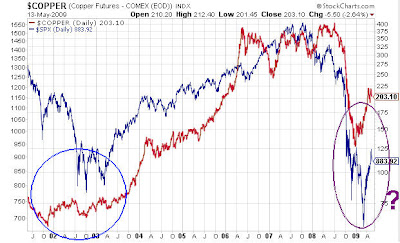Home » Uncategorized (Page 39)
Category Archives: Uncategorized
Copper, China, S&P and economic recovery
China is the largest consumer of copper—with China's "green shoots" greener than anywhere in the world, we can only hope the economic recovery is indeed around the corner. That being said, expect more robust growth in emerging markets and only anemic recovery in the US.

Something about CFA exam of 2009
More than 120,000 people enrolled in the CFA exam in June 2009.
Dollar and gold
US Dollar has been depreciating again in recent weeks as risk appetite comes back to the market. At the same time, gold price has been steadily rising (see chart below).
What determines the price of gold? I tend to think two things matter most: $ and inflation. Of course, $ and inflation are interconnected. Higher inflation tends to correlate with lower $ value. I call the negative correlation between US dollar and gold the first order in determining gold price.
The second order factor is risk appetite. It can be measured by market volatility, for example, VIX. As discussed previously, gold is attractive to investors for various reasons. During panic time, gold, same as US dollar, is often treated as investment safe haven. So no wonder gold and the Dollar often move in the same direction. This is evident in the graph above, from mid January to early March this year.
Of course, in the short run, gold price may be complicated by many other things. One such thing is liquidity. In the summer of 2007 and 2008, during the height of the market panic, gold, for a brief period, dropped sharply with the rise of market volatility. This was because a lot of institutional investors were force to sell in order to meet margin calls: They had to sell their gold holding to raise cash.
Finally, I share with you a graph of the dollar and gold with longer history, dating back to early 90s.
Abby Cohen on market outlook
Abby Cohen of Goldman Sachs on market outlook:
Graduating is not fun in 2009
This week is the graduation week all cross the country. Graduating in 2009 is not fun: with unemployment rate rising to 8.9% and surely going to get worse in coming quarters, the job is harder to find than ever. Even you find a job, your wage/salary is likely to be much lower than in good times. And according to the research by Yale economist Lisa Kahn, this initial gap in salary tends to persist over many years to come.
The graph below shows that when unemployment rate is at 7.1%, the initial salary offer is more than 10% lower than when the unemployment rate is at 5.3%. When the unemployment rate is at 9.6%, the initial offer, on average, is more than 30% lower than in good times.
Worse yet, the gap does not dissapear and it tends to perist for a long period of time. As shown in the graph, even after 15 years, the gap is still at 10% for people hired when unemployment rate is at historically high level. Call it “the curse of class of 2009“.

(click to enlarge; source: WSJ)
Now with some positive note from Andy Rooney at 60 mins, “graduations are not what’s wrong with the world”:
Geithner Sucks and Pass/Pass*
A hilarious video on bank stress test.
WSJ reports how some banks battled with the government and managed to force government to make concessions and lower the capital requirement.
Here are some interesting excerpts:
At times, frustrations boiled over. Negotiations with Wells Fargo, where Chairman Richard Kovacevich had publicly derided the stress tests as “asinine,” were particularly heated, according to people familiar with the matter. Government officials worried San Francisco-based Wells might file a lawsuit contesting the Fed’s findings.
…
Wells Fargo’s capital hole shrank to $13.7 billion, according to people familiar with the matter. Before adjusting for first-quarter results and other factors, the figure was $17.3 billion, according to a federal document.
…
Citigroup’s capital shortfall was initially pegged at roughly $35 billion, according to people familiar with the matter. The ultimate number was $5.5 billion. Executives persuaded the Fed to include the future capital-boosting impacts of pending transactions.
…
Bank of America’s final gap was $33.9 billion, down from an earlier estimate of more than $50 billion, according to a person familiar with the negotiations.
And government used tier 1 capital ratio instead of TCE ratio to measure capital adequacy.
Conundrum in bond yields
The Fed is in a uncharted territory trying to buy long-term bonds with objectives to lower inflation expectations and government financing cost. Can it succeed? Or are we going to see an inevitable rise of government bond yields (steepen yield curve)? And mortgage rates will also have to go up again suffocating the slight chance of housing market recovery?
Read the analysis from Wall Street Journal.
Eating time and obesity
This interesting graph seems to show that there is a negative correlation between how much time you spend on eating and obesity.

(click to enlarge; source: NYT)
Less time spent on eating could mean people eat more fast food, which tend to be less healthy. Slow eating also helps you digest better, possibly preventing building up fat.
New Zealanders seem to be an outlier in the graph. This could be they eat too much dairy food.





![[Chart]](https://s.wsj.net/public/resources/images/P1-AP851_STRESS_NS_20090508232418.gif)